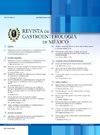系统回顾:质子泵抑制剂对幽门螺杆菌生理机能的影响
IF 1.7
Q3 GASTROENTEROLOGY & HEPATOLOGY
引用次数: 0
摘要
幽门螺杆菌是一种革兰氏阴性杆菌,定植于胃粘膜,感染世界上一半以上的人口。治疗包括两种抗生素和质子泵抑制剂(PPI),有利于细菌的复制和增强抗生素的活性。尽管质子泵抑制剂在治疗幽门螺杆菌感染中的重要性,但PPIs影响细菌生理的确切机制尚不清楚。我们的目的是收集有关PPIs对幽门螺杆菌生理影响的信息,以及它们在细菌中产生改变的机制。方法利用PubMed、Science Direct和LILACS数据库进行文献检索,检索所有语种的临床前和临床原始文献。结果PPIs的磺胺形式对幽门螺杆菌有影响,包括诱导结构改变,抑制细菌生长,干扰酶,如脲酶、三磷酸腺苷酶和乙醇脱氢酶。结论PPIs的亚砜酰胺形式与细菌结构和酶的结合是体外改变幽门螺杆菌生理的主要机制,但在临床研究中尚未确定它们如何诱导细菌的改变。本文章由计算机程序翻译,如有差异,请以英文原文为准。
Revisión sistemática: efecto de los inhibidores de la bomba de protones sobre la fisiología de Helicobacter pylori
Introduction and aims
Helicobacter pylori is a Gram-negative bacillus that colonizes the gastric mucosa and infects more than half of the world population. Treatment consists of two antibiotics and a proton pump inhibitor (PPI) that favors the replication of the bacterium and enhances the activity of the antibiotics. Despite the importance of proton pump inhibitor use in treating H. pylori infection, the precise mechanisms through which PPIs affect the physiology of the bacterium are not yet understood.
Aim
Our aim was to compile information pertaining to the effect of PPIs on the physiology of H. pylori and the mechanisms through which they produce alterations in the bacterium.
Methods
A bibliographic search was conducted, utilizing the PubMed, Science Direct, and LILACS databases, and included preclinical and clinical original articles published in any language.
Results
The sulfenamide form of PPIs was shown to have effects on H. pylori, including the induction of structural changes, inhibition of bacterial growth, and interference with enzymes, such as urease, ATPases, and alcohol dehydrogenase.
Conclusions
The binding of the sulfenamide form of PPIs to the bacterial structural and enzymatic components was the main mechanism through which H. pylori physiology was altered in vitro, but how they induce alterations in the bacterium was not established in the clinical studies analyzed.
求助全文
通过发布文献求助,成功后即可免费获取论文全文。
去求助
来源期刊

Revista de Gastroenterologia de Mexico
GASTROENTEROLOGY & HEPATOLOGY-
CiteScore
1.60
自引率
12.50%
发文量
102
审稿时长
12 weeks
期刊介绍:
La Revista de Gastroenterología de México es el órgano oficial de la Asociación Mexicana de Gastroenterología. Sus espacios están abiertos a los miembros de la Asociación como a todo miembro de la comunidad médica que manifieste interés por utilizar este foro para publicar sus trabajos, cumpliendo con las políticas editoriales que a continuación se mencionan. El objetivo principal de la Revista de Gastroenterología de México, es publicar trabajos originales del amplio campo de la gastroenterología, así como proporcionar información actualizada y relevante para el área de la especialidad y áreas afines. Los trabajos científicos incluyen las áreas de Gastroenterología clínica, endoscópica, quirúrgica y pediátrica.
 求助内容:
求助内容: 应助结果提醒方式:
应助结果提醒方式:


